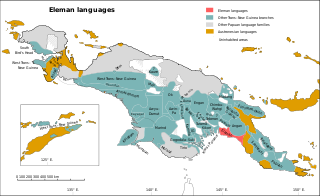Related Research Articles
The Huastec or Téenek are an indigenous people of Mexico, living in the La Huasteca region including the states of Hidalgo, Veracruz, San Luis Potosí and Tamaulipas concentrated along the route of the Pánuco River and along the coast of the Gulf of Mexico.

Mesoamerican languages are the languages indigenous to the Mesoamerican cultural area, which covers southern Mexico, all of Guatemala, Belize, El Salvador, and parts of Honduras, Nicaragua and Costa Rica. The area is characterized by extensive linguistic diversity containing several hundred different languages and seven major language families. Mesoamerica is also an area of high linguistic diffusion in that long-term interaction among speakers of different languages through several millennia has resulted in the convergence of certain linguistic traits across disparate language families. The Mesoamerican sprachbund is commonly referred to as the Mesoamerican Linguistic Area.

Bahrani Arabic is a variety of Arabic spoken by the Baharna in Eastern Arabia and Oman. In Bahrain, the dialect is primarily spoken in Shia villages and some parts of Manama. In Saudi Arabia, the dialect is spoken in the governorate of Qatif. In Oman, it is spoken in the governorates of Al Dhahirah and Al Batinah.

Afshar or Afshari is a Turkic dialect spoken in Turkey, Iran, Syria, and parts of Afghanistan by the Afshars. Ethnologue and Glottolog list it as a dialect of the South Azerbaijani language. The Encyclopædia Iranica lists it as a separate Southern Oghuz language.
Myriandus was an ancient Phoenician port on the Mediterranean Sea's Gulf of Alexandretta. Its ruins are located near the modern city of İskenderun in southern Turkey.
Kala, also known as Kela, is an Austronesian language spoken by about 2200 people in several villages along the south coast of the Huon Gulf between Salamaua Peninsula and the Paiawa River, Morobe Province, Papua New Guinea.
Bravanese, also called Chimwiini or Chimbalazi, is a language related to Swahili spoken by the Bravanese people, who are the predominant inhabitants of Barawa, or Brava, in Somalia. Maho (2009) considers it a distinct dialect, and it has been classified as a Northern Dialect of Swahili. However, it strongly distinguishes itself from standard Swahili under all linguistic considerations.
Historical regions are geographical regions which, at some point in history, had a cultural, ethnic, linguistic or political basis, regardless of latter-day borders. There are some historical regions that can be considered as "active", for example: Moravia, which is held by the Czech Republic, is both a recognized part of the country as well as a historical region. They are used as delimitations for studying and analysing social development of period-specific cultures without any reference to contemporary political, economic or social organisations.
The fundamental principle underlying this view is that older political and mental structures exist which exercise greater influence on the spatial-social identity of individuals than is understood by the contemporary world, bound to and often blinded by its own worldview - e.g. the focus on the nation-state.

The Eleman languages are a family spoken around Kerema Bay, Papua New Guinea.

The Turama–Kikorian languages are a family identified by Arthur Capell (1962) and part of the Trans–New Guinea languages (TNG) family in the classifications of Stephen Wurm (1975) and Malcolm Ross (2005). The family is named after the Turama River and Kikori River of southern Papua New Guinea; the alternative name is based more narrowly on the Omati River.

The Kamula–Elevala languages are a small family of the Trans–New Guinea languages spoken in the region of the Elevala River.

The Engan, or more precisely Enga – Southern Highland, languages are a small family of Papuan languages of the highlands of Papua New Guinea. The two branches of the family are rather distantly related, but were connected by Franklin and Voorhoeve (1973).

The Gulf of Mexico is an ocean basin and a marginal sea of the Atlantic Ocean, mostly surrounded by the North American continent. It is bounded on the northeast, north and northwest by the Gulf Coast of the United States; on the southwest and south by the Mexican states of Tamaulipas, Veracruz, Tabasco, Campeche, Yucatán, and Quintana Roo; and on the southeast by Cuba. The Southern U.S. states of Texas, Louisiana, Mississippi, Alabama, and Florida, which border the Gulf on the north, are often referred to as the "Third Coast" of the United States.

Pawaia, also known as Sira, Tudahwe, Yasa, is a Papuan language that forms a tentative independent branch of the Trans–New Guinea family in the classification of Malcolm Ross (2005).
Toaripi, or East Elema, is a Trans–New Guinea language of Papua New Guinea.
Mandaya is an Austronesian language of Mindanao in the Philippines. It may be intelligible with Mansaka.

The Atlas linguistique de la France is an influential dialect atlas of Romance varieties in France published in 13 volumes between 1902 and 1910 by Jules Gilliéron and Edmond Edmont. Whereas Georg Wenker had used postal questionnaires to compile his pioneering Sprachatlas des deutschen Reichs in 1888, Gilliéron employed a fieldworker, Edmond Edmont. Between 1896 and 1900, Edmont conducted 700 interviews at 639 locations throughout the countryside of France, southern Belgium, western Switzerland, the Channel Islands, and the Aosta Valley and the Occitan Valleys of Piedmont in Italy, using a questionnaire of over 1,500 items devised and continually revised by Gilliéron. The results were collated and analysed by Gilliéron and his assistants.

The Papuan Gulf languages are a proposed language family of Papuan languages spoken inland from the large gulf that defines the shape of southern Papua New Guinea.
Gilit Mesopotamian Arabic, also known as Iraqi Arabic, Mesopotamian Gelet Arabic, or simply Mesopotamian Arabic is one of the two main varieties of Mesopotamian Arabic, together with North Mesopotamian Arabic.
Proto-Trans–New Guinea is the reconstructed proto-language ancestral to the Trans–New Guinea languages. Reconstructions have been proposed by Malcolm Ross and Andrew Pawley.
References
- ↑ Algeo, John (2010). The Origins and Development of the English Language (6 ed.). Boston: Wadsworth. p. 196. ISBN 978-1-4282-3145-0.